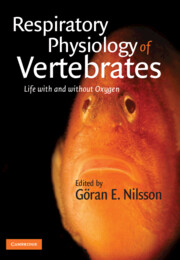Book contents
- Frontmatter
- Contents
- List of contributors
- Preface
- Abbreviations
- Part I General principles
- Part II Special cases
- 5 Adaptations to hypoxia in fishes
- 6 Breathing air in water and in air: the air-breathing fishes
- 7 Air breathers under water: diving mammals and birds
- 8 Vertebrate life at high altitude
- 9 Surviving without any oxygen
- Index
- References
5 - Adaptations to hypoxia in fishes
Published online by Cambridge University Press: 05 June 2012
- Frontmatter
- Contents
- List of contributors
- Preface
- Abbreviations
- Part I General principles
- Part II Special cases
- 5 Adaptations to hypoxia in fishes
- 6 Breathing air in water and in air: the air-breathing fishes
- 7 Air breathers under water: diving mammals and birds
- 8 Vertebrate life at high altitude
- 9 Surviving without any oxygen
- Index
- References
Summary
Hypoxia in the aquatic environment
Both ocean and freshwater environments can challenge the inhabitants with large spatial and temporal variations in oxygen levels. As we pointed out in Chapter 1, oxygen has a low solubility and diffuses slowly in water. Further, the solubility of O2 in water falls with increases in temperature. At close to 0°C, air-saturated freshwater contains 10.2 ml O2 per liter, whereas at tropical temperatures (30°C) fresh water can only hold 5.9 ml O2 per liter when air saturated. These figures are even 20% or so lower in sea water, as salt reduces oxygen solubility (Table 1.1 in Chapter 1).
These physical factors make water breathing more challenging than air breathing, and particularly so when water oxygen levels are below air saturation. The oxygen that enters the water from the atmosphere, or is produced by photosynthesizing algae and phytoplankton, can be rapidly consumed by organisms and chemical oxidation reactions. There is no photosynthetic O2 production in the dark, and O2 diffusion is extremely slow in water (see Chapter 1), so oxygen movement to depth depends on convection, i.e. oxygen is carried to depth by water flow rather than diffusion. Surface waters generally have high oxygen content because of both photosynthesis and diffusion of oxygen from air. Aeration is increased by convection and mixing at the surface, a process that is strongly influenced by wind.
- Type
- Chapter
- Information
- Respiratory Physiology of VertebratesLife With and Without Oxygen, pp. 131 - 173Publisher: Cambridge University PressPrint publication year: 2010
References
- 10
- Cited by



